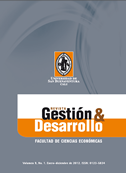La Revista Gestión & Desarrollo proporciona acceso abierto e inmediato a su contenido, basada en el principio de ofrecer al público un acceso libre a las investigaciones para ayuda a un mayor intercambio global de conocimiento.
Excepto que se establezca de otra forma, el contenido de esta revista cuenta con una licencia Creative Commons Attribution-NonCommercial-NoDerivatives 4.0 International (CC BY-NC-ND 4.0) que puede consultar en http://creativecommons.org/licenses/by-nc-nd/4.0/
- Attribution — You must give appropriate credit, provide a link to the license, and indicate if changes were made. You may do so in any reasonable manner, but not in any way that suggests the licensor endorses you or your use.
- NonCommercial — You may not use the material for commercial purposes.
- NoDerivatives — If you remix, transform, or build upon the material, you may not distribute the modified material.
- No additional restrictions — You may not apply legal terms or technological measures that legally restrict others from doing anything the license permits.
Resumen
El servicio al cliente se considera una estrategia que genera ventaja competitiva a las empresas frente a sus competidores. En el presente estudio, se analizaron los efectos de una buena o mala distribución física en el caso de los domicilios y cómo influye positiva o negativamente en la imagen corporativa de las organizaciones. Los resultados permiten evidenciar el importante papel que juega la logística como prolongación del servicio al cliente y factor determinante en la fidelidad del usuario final.
Palabras clave:
Referencias
– ALFARO, F. (2004).Temas clave en marketing relacional Madrid: McGraw Hill.
– BALLOU, R. (1991). Logística empresarial, control y planificación. Madrid: Editorial Díaz de Santos.
– BASTOS, A. (2007). Distribución logística y comercial. Barcelona: Ideas Propias.
– CZEPIEL, J. y ROSENBERG, L. (1977). “Consumer satisfaction: concept and measurement”. In: Journal of the Academy of Marketing Science, V. 5, pp. 403-411.
– CHRISTOPHER, M. (2008). Logística: aspectos estratégicos. Bogotá: Limusa.
– DANE. (2009). Documento de fuentes estadísticas del municipio de Santiago de Cali.
BURBANO, E.; MORALES, R. (2010). “Incidencia de la logística en el marketing”. En: Revista Guillermo de Ockham. V. 8.
– DIAZ, E. (2003). "Marketing y competitividad, ¿relación o contradicción?" En: Economía y desarrollo. No. 4.
– DÍEZ DE CASTRO, E. (1997). Distribución comercial. Madrid: Mc Graw Hill.
– DOMBERGER, S. (1998). The Contracting Organization.A Strategic Guide to Outssourcing, Oxford University Press.
– GÓMEZ, M.; ACEVEDO, J. (1998). Logística del aprovisionamiento. Bogotá: Colección logística.
– JURAN J. (1994). Manual de control de la calidad. Barcelona: Reverte.
– KLEIN, N. (1999). No logo: el poder de las marcas. Barcelona: Paidós.
– KOTABE, M. (2001). Administración de la mercadotecnia. México: Thompson Learning.
– KOTLER, P.; KELLER, K. (2006). Dirección de marketing México: Pearson Prentice Hall.
– KRUGMAN, P. (1994). Geografía y comercio. Madrid: Bosch Editores.
– LAMB J.; HAIR, J. y McDANIEL, C. (2002). Marketing. Prentice Hall.
– LAMBERT, D. (1989) “Supply Chain Metrics” In: The International Journal of Logistics Management, 12 (1).
– LONG, D. (2006). Logística internacional. México: Noriega Editores.










